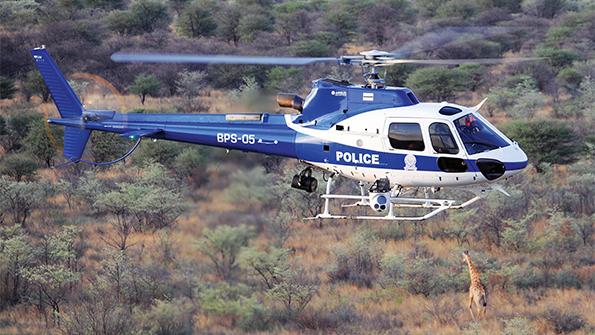
A series of research programs, to be partly funded through France’s aerospace stimulus package, will develop the building blocks for a successor to Airbus Helicopters’ best-selling H125 single-engine light helicopter.
Although the new rotorcraft is still at least a decade away, the PlanAero package—developed to help the French aerospace industry through the novel coronavirus pandemic—confirms industry hints that the manufacturer is still looking to address the conventional light-helicopter market at a time when urban air mobility systems are grabbing the investment and limelight.
- PlanAero is funding the Helybrid hybridization research project
- Airbus working on a light-helicopter tech demonstrator for 2029
The H125, known by its French product name Ecureuil (Squirrel) and marketed as the AStar in the U.S., was originally developed by predecessor company Aerospatiale during the 1970s. Some 5,000 H125s have been produced during its 45-year production run, with the type in use with commercial, military and parapublic agencies. The most recent version, the AS350B3e, was rebranded as the H125 in 2015, when the company was renamed from Eurocopter to Airbus Helicopters.
The H125 is currently built at Airbus’ plant in Marignane, France, near Marseille, but kits are also sent to Helibras in Brazil and Airbus Helicopters in Columbus, Mississippi, for final assembly for the Latin American and U.S. markets, respectively. Airbus has been looking at the development of an Ecureuil replacement for more than a decade and had considered opening part of the design effort to the company’s Brazilian affiliate Helibras in part because of the heavy demand for the platform in Latin America.
Any future platform is likely to remain a conventional helicopter because the wide range of missions it is expected to perform—everything from training to law enforcement to firefighting and aerial lifting—are unlikely to disappear.
Efforts will be focused on improved aerodynamics, weight reduction and higher turbine output, with the aim of initially reducing fuel consumption by 40%, Tomasz Krysinski, Airbus Helicopters head of research and innovation, tells Aviation Week. “These three components should get us to 40%,” Krysinski says, while the addition of electric hybridization of the aircraft could add another 10% reduction.
An Airbus research and development program called Helybrid will receive funding from a €300 million ($338 million) aviation decarbonization investment. Helybrid will demonstrate hybridization of lightweight-helicopter propulsion.
Projects called Compaq and Eproptech, the PlanAero documents state, will work on electrical network technologies to allow megawatts of electrical power to be used on an aircraft.
“The ultimate step is to go to another sort of energy, which could be hydrogen or fuel cells,” Krysinkski says.
The plans are part of Airbus Helicopters’ long-term innovation road map to develop autonomy, electrification, hybridization and alternative technologies, so-called techno-bricks, which will contribute to reducing the carbon footprint of their future models. Airbus is planning to fly a demonstrator for the future light helicopter around 2029 to prove the technologies for 40% fuel-burn reduction, and if the hydrogen technologies are mature enough, they could fly, too.
Krysinski notes significant advances in hydrogen-fuel-cell technology, notably in the fixed-wing arena, but says the power requirements for a helicopter remain a significant hurdle.
Currently, the company is gearing up to tackle the hybridization challenge. In 2011, it successfully flight-tested an Ecureuil with an electric motor to drive the dynamic system of the main rotor. Designed as a safety device, the motor would kick in when the aircraft’s systems detected main rotor speed drop, usually the result of an engine failure, giving the pilot more time to achieve a smooth and safer autorotation with a reduced rate of descent.
Airbus is to begin modifying a single-engine H130 helicopter with a 120-kW motor, which will act as an electric backup system (EBS) to provide power for a safe rotation, whereas later tests will see two 120-kW motors connected in parallel to the dynamic system, which would allow the aircraft to make 2 min. of electric-powered flight in a low-power setting. Modification of the test helicopter should begin during September. It will fly in early 2021.
“Motors have made very big progress . . . and compared to 2011, you can get twice the energy from 1 kg [2.2 lb.] of batteries than before,” Krysinski explains.
“This is a good steppingstone toward the hybrid rotorcraft,” he says. “It opens the chapter, a revolution in rotary-wing performance.”
Hybridization can also introduce new functions to lower the noise levels, Krysinski notes. “With an electric system, we can get the torque very quickly, and this gives us an extra degree of freedom,” he says. “We can reduce the rotational speed of the turbine, and this provides lower noise emissions.”
Airbus has not said who it is partnering with on the EBS project, but the company will work with Safran Helicopter Engines in the long term on a hybrid-electric propulsion system. The two companies announced commitments at last year’s Paris Air Show on hybridization for the European Union’s Clean Sky 3, now the Clean Aviation research and development program.
